28 Days Later is Not a Zombie Movie
Come at me, bro.

A few days ago, one of those question-meme things was circling the various social media sewers: “What five topics can you talk about for twenty minutes without any preparation?”
My answers were:
- “Why it was a mistake to break up Xander and Anya in Season Six of Buffy the Vampire Slayer, and how it was the first real concrete hint of who Joss Whedon truly was as a person.”
- “Understanding the formula for a good Predator movie, and why it is absolutely necessary, if you want to make a good Predator movie.” Which is a topic that I’ve already talked about here.
- “The long and convoluted histories of various Marvel and DC comic book characters.” Which is also something I do regularly. Very very regularly.
- “Favorite sandwiches I’ve had.”
- And finally… “Why 28 Days Later isn’t a zombie movie.”
Then, because our phones spy on us every single moment of every single day, the picture I posted above popped up on my timeline. It reads: “Zombie Sequel ‘28 Years Later’ lands at Sony.” Which, y’know… good for them. I know I'm definitly interested in seeing it, I love that franchise, but there’s just one problem, and that is: 28 Years Later is not a zombie film.
And the reason why is simple…
The films of the 28 Days Later franchise have no zombies in them.

28 Days Later
A group of animal rights activists break into a research lab and free a caged chimp that turned out to be infected with a highly contagious rage-inducing virus. The chimp then goes sick-house on all of them, which then unleashes a vicious plague that burns through the populace of England like a wild fire.
Fade to black, and the credits read: 28 Days Later…
A London bike courier named Jim wakes up from a coma and finds himself in a wrecked and seemingly deserted London. Seemingly… until the Infected find him. Blinded by rage, they chase him across the city, and it’s only a chance encounter with Selena, a fellow survivor, that he is able to survive his first day.
TANGENT: You may have noticed that the beginning of 28 Days Later is almost exactly the same as the beginning of both the comic book and the TV show, The Walking Dead, by Robert Kirkman, the franchise's “weirdly often involved in lawsuits due to some questionable work-related issues” creator. This is because Kirkman obviously yoinked the idea upon seeing the film, which came out a full year before the first issue of The Walking Dead, but to this day, he still pretends like this wasn't the case, and that it was just a coincidence.
I mean… come on, Rob.
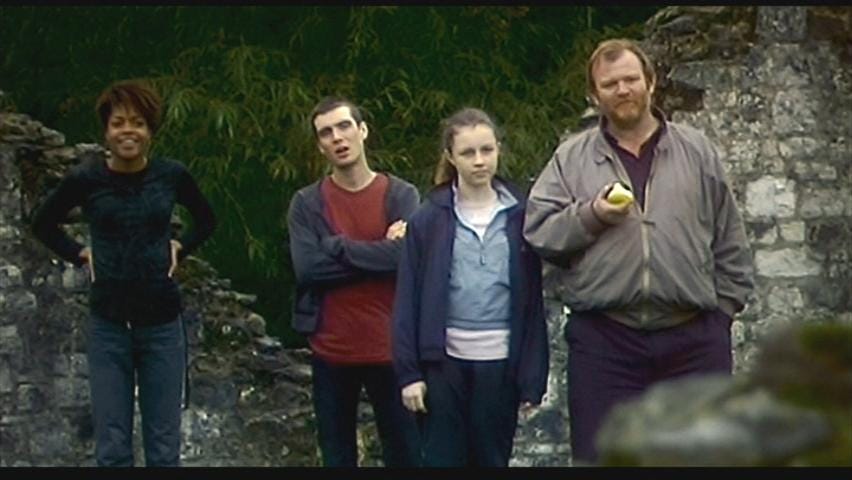
Anyway, soon enough, Jim and Naomi meet Frank, a former cab driver, and his daughter Hannah, and together the small group embarks on a perilous journey out of London and across England to what they hope will be safety. Unfortunately, all that awaits them is more destruction, more Infected, and a group of soldiers who have chosen a country estate for their Alamo, but who are slowly cracking under the strain of holding out against the unrelenting rage of the Infected.
Written by the Oscar nominated writer, Alex Garland, and directed by the Oscar nominated director, Danny Boyle, with Oscar nominated actors Cillian Murphy and Brendan Gleeson, as well as some not-as-highly-recognized-but-still-good talents like Naomie Harris and Christopher Eccleston, it is a respectable “zombie” movie, one that was almost considered to be art by the film snobs. Almost. Not quite. But almost.
Also, notably, there are no zombies in it.
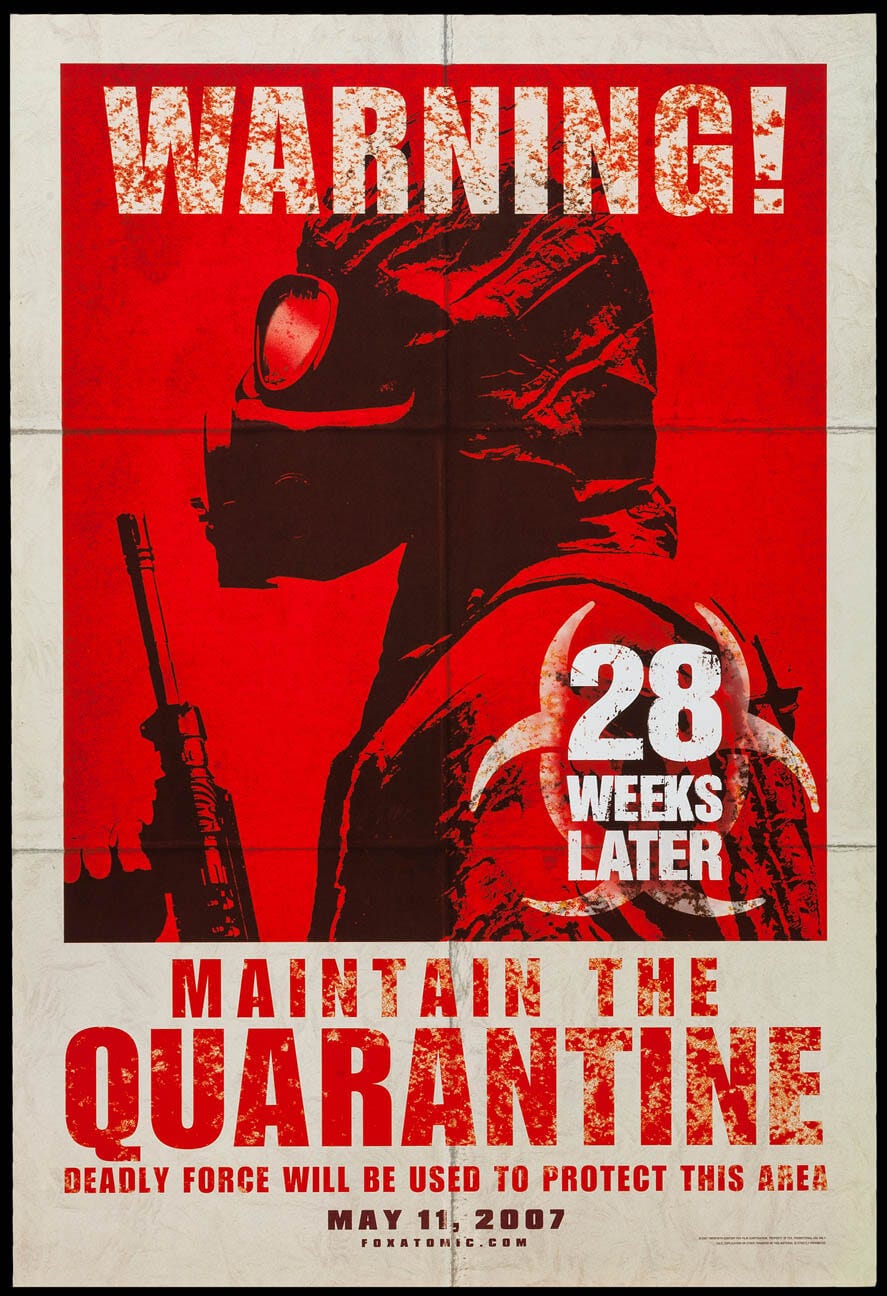
28 Weeks Later
Opening during the first 28 days, the sequel begins with a man named Don, his wife Alice, and four others, hiding in a cottage outside of London. When a terrified boy appears on their doorstep, Don lets him in, realizing too late that the Infected have followed him. In the chaos of the Infected’s attack, Don tries to get Alice to abandon the boy and run with him, but she refuses, thinking of their own children—who are visiting some family overseas—so Don escapes alone, while Alice, the boy, and the rest of the survivors are all presumably killed.
Fade to black, and the credits read: 28 Weeks Later…
Six months after the original outbreak, the Rage Virus has all but wiped out everyone who was trapped within the quarantine of the British Isles, and all of the Infected who were also contained there have died, either due to injuries, or by starvation. At the head of a UN/WHO reclamation effort, the U.S. Army arrives, including the handsome Brigadier General Stone, Chief Medical Officer Major Scarlet Levy, and Delta sniper Sergeant Doyle. The task force declares that the infection is gone, so the danger is now over, and begins setting up an outpost on the Isle of Dogs in London, from which they plan to begin the process of restoring order, resettling, and reconstruction.
Because of this effort, English citizens have slowly started returning to British soil. Don is now in charge of the refugee facilities on the Isle of Dogs, and arriving with the latest refugee group are his children, big sister Tammy and little brother Andy. The kids naturally have questions about their Mom, but Don is evasive, so Tammy and Andy sneak out of quarantine, and into the seemingly empty and abandoned city of London, going to the home they last saw over six months ago.
What they find there sets off a chain of events rooted in a simple truth… The virus is not gone, and it is even more dangerous than before.

Headed up by a less impressive director this time, and written by a gaggle of much less impressive writers in general, this is where the franchise leans a little harder into its schlocky genre roots. Still, it was kind of respectable, as it starred Jeremy Renner as Doyle, Robert Carlyle as Don, Rose Byrne as Scarlet, Idris Elba as Stone, and Imogen Poots as Tammy, someone I think would be a much bigger star if her name wasn’t Imogen Poots.
But one thing you won’t find in this movie?
Zombies.
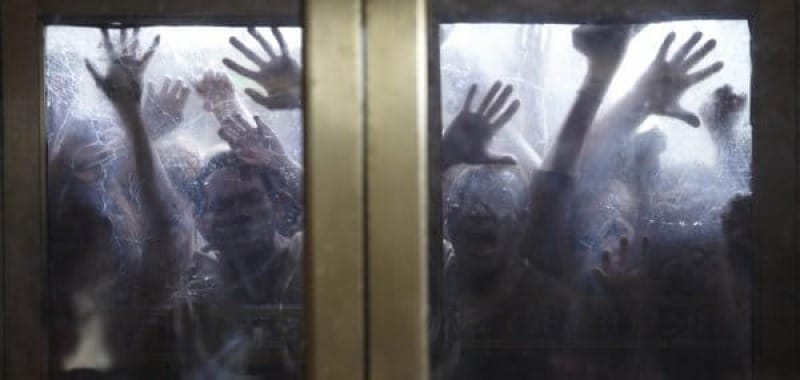
It's true.
These movies are outbreak movies, sure. They’re post-apocalyptic survival horror, definitely. And while they may share quiet a few of the same tropes as most zombie movies, they still aren’t zombie movies. So that’s the question, right? Why aren't they zombie movies, because they sure do seem like zombie movies, right?
Like I said... It's because there are no zombies in them.
There’s two distinct types of zombies in Western Cinema. There’s Voodoo Zombies, obviously. Voodoo zombies movies have their own specific rules that are supposedly rooted in the religious practices of Afro-Caribbean communities, rules that I’d be willing to bet are super problematic, not to mention probably more than a bit racist, but more importantly, for what we’re talking about here, they’re rules that we’re not concerned with. This is because, if the 28 Days movies were zombie films… which they aren’t… but if they were, they most certainly would not be Voodoo Zombie movies.
The other type of zombie in Western Cinema, for lack of a better term, we’re going to call Romero Rules Zombies. Night of the Living Dead was first released in 1968. Directed by George Romero, and written by George Romero and John Russo, while the flesh-eating monsters in that particular film are mostly called ghouls, it is still considered to be the first real appearance of the modern Romero Rules zombie in pop culture. And the more familiar ideas and tropes commonly found in a typical Post-apocalyptic zombie story soon followed in earnest with the release of Night's sequeal in 1978, Dawn of the Dead.
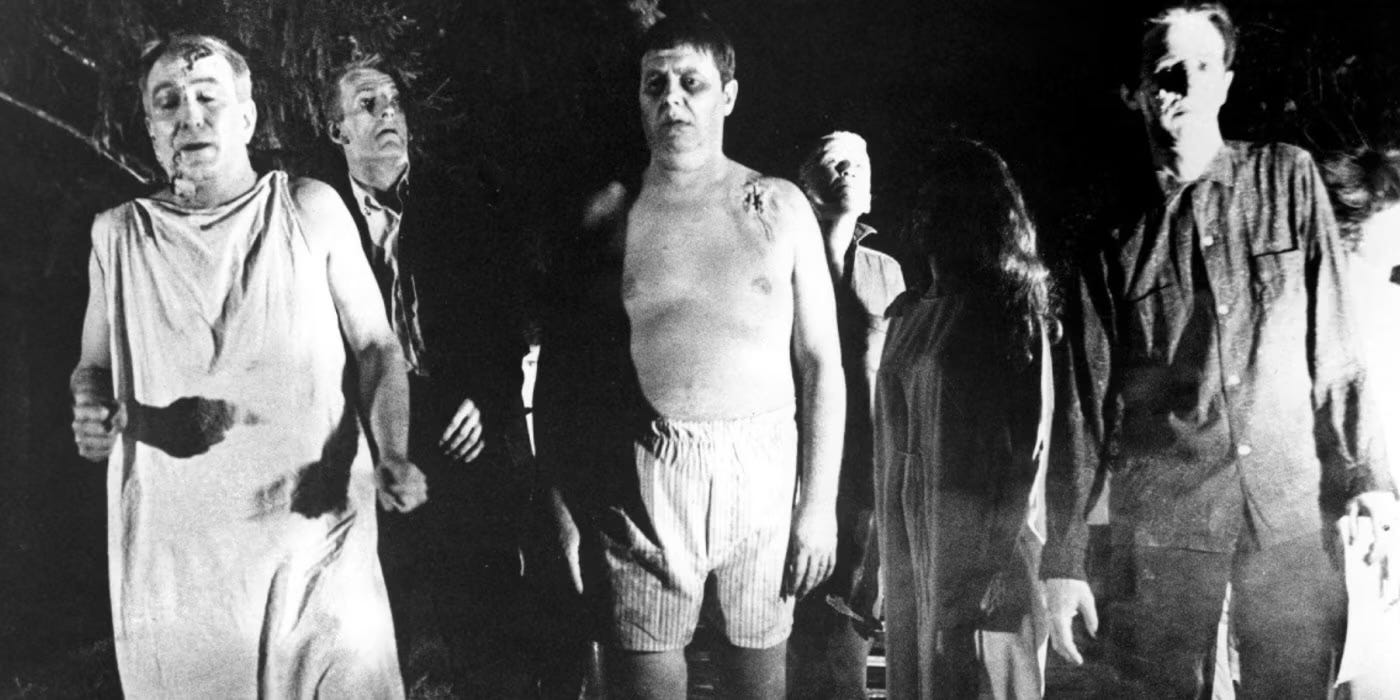
In essence, these films set the standard in pop culture for what we’re calling Romero Rules Zombies. At this point, Romer Rule Zombies are inarguably the most popular kind of zombie between the two types, and the standards that Night and Dawn first set have been basically adhered to throughout the genre ever since.
It’s called precedent, people, look it up.
So, when it comes to Romero Rules Zombies, whether they are fast or slow, smart or dumb, funny or scary, there’s one consistent rule linking them all... they are all the recently reanimated dead. This is a core rule that defines the entire genre. They might die from the virus itself, or from the injuries sustained during infection, or sometimes even for unrelated issues, but in a Romero Rules Zombie story, when a person dies, they get up and kill. The people they kill, get up and kill!
Additionally, as I said, if the 28 Days movies actually were zombie movies… which they aren’t… but if they were, they wouldn’t be Voodoo Zombies, they’d be Romero Rules Zombies. But the reason they aren’t Romero Rules Zombies is because they don’t adhere to the core defining rule of the genre, due to one thing we are clearly shown in both 28 Days Later and 28 Weeks Later…
The Infected aren’t dead.
They are infected by direct fluidic contact, yes, but they don’t then die and reanimate. They’re still alive the whole time. Also, they exist only to attack, and in doing so, further spread the virus. They don’t feed when they attack, they just rend and ravage. If they’re shot anywhere, or they fall, or cut themselves, or they get run over, they could bleed to death, or die from the injury, or even from the resulting gangrene that comes with an infected wound. Also, unlike Romero Rules Zombies, the Infected don’t rot as time goes on, they grow more and more emaciated, and eventually, they starve to death. AND... this is important... when they do die, they don’t reanimate to kill again. This is because all of the “zombies” you see in the 28 Days Later films are just living people who are infected with a virus.
In short, they’re people who should have worn their PPE, and maybe practiced a little social distancing…
So, in the simplest terms, if the Infected in the 28 Days movies are still alive, then they aren’t Romero Rules Zombies, and that means, much like other films… like, for instance, Driving Miss Daisy, or Green Book, or Steel Magnolias, or even Billy Lynn's Long Halftime Walk, the films of the 28 Days franchise aren’t zombie movies because there are no zombies in them.
I know, I know… who really gives a fuck?
Fine. Okay, admittedly, this is only an "academic" distinction at best, something that only weirdos and obsessives like myself might truly care about. I’ll admit that, fine, but… if that’s not also you, then why the hell else are you here? Either way, I’m right. This is all right and true. In your face, doubter. In the end, all I’m really saying here is this… Know your enemy! Don't you understand? I'm trying to help you here! I'm trying to keep you alive!
These people are dead, and yet… they walk! They feed!
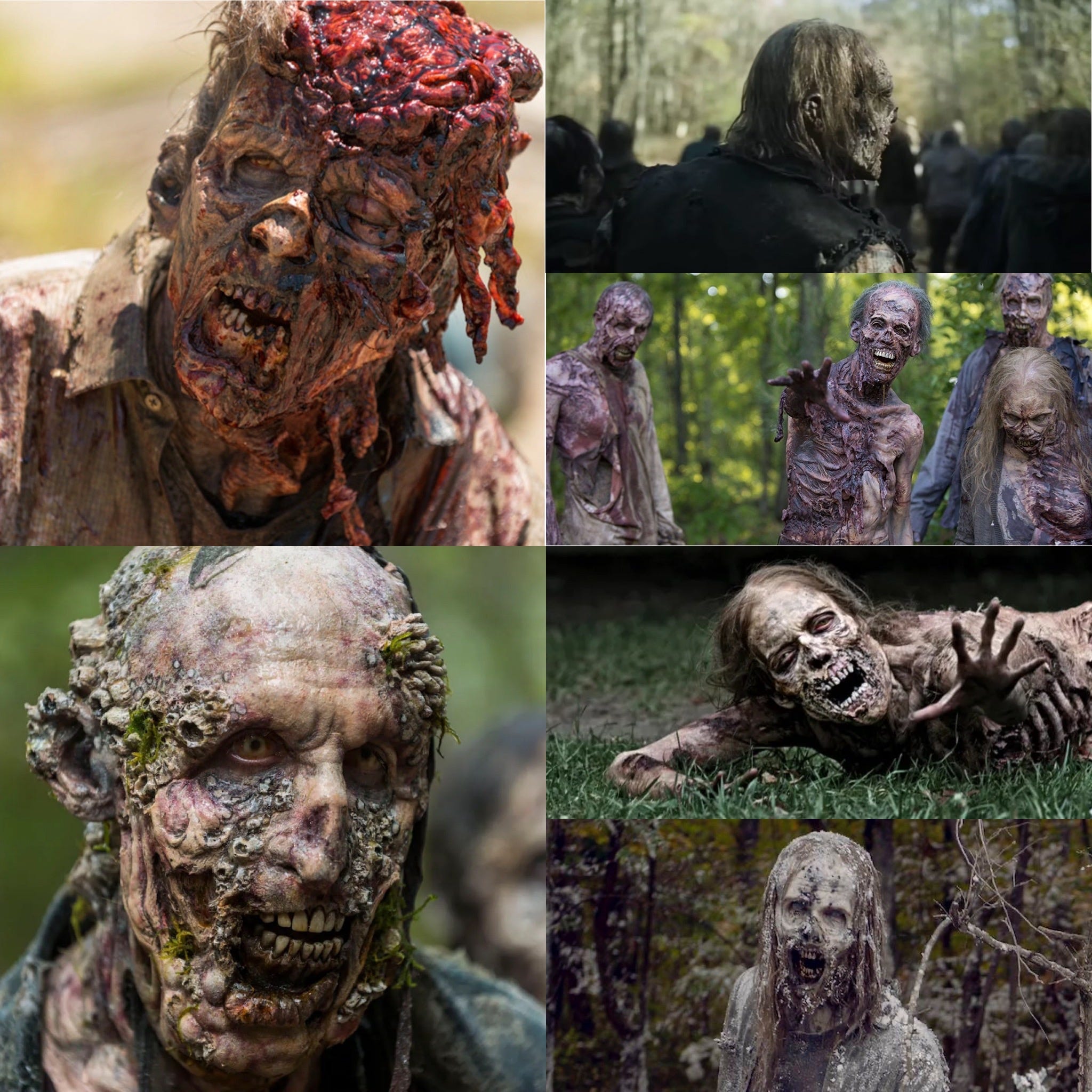
These people are infected! Infected with… RAGE!

Understanding this difference, and what it means, should you find yourself in a suddenly relevant apocalyptic situation, will dictate the correct course of action to take, which could mean the difference between life and death, people!
Also, seriously, avoid infection, people.
Wear a mask while indoors or in crowded spaces, you god damn dummies.
